Basalt Rock Market
Basalt Rock Market Size and Share Forecast Outlook 2025 to 2035
Basalt rock market is projected to grow from USD 2.0 billion in 2025 to USD 4.2 billion by 2035, at a CAGR of 7.7%. Basalt Fiber will dominate with a 53.0% market share, while building and construction will lead the end use segment with a 35.5% share.
Basalt Rock Market Forecast and Outlook 2025 to 2035
The global basalt rock market is projected to reach USD 4.2 billion by 2035, recording an absolute increase of USD 2.2 billion over the forecast period. The market is valued at USD 2.0 billion in 2025 and is set to rise at a CAGR of 7.7% during the assessment period.
The overall market size is expected to grow by approximately 2.1 times during the same period, supported by increasing demand for sustainable construction materials and lightweight composite applications worldwide, driving demand for high-performance basalt fiber solutions and increasing investments in green building technologies and infrastructure modernization programs globally.
Quick Stats for Basalt Rock Market
- Basalt Rock Market Value (2025): USD 2.0 billion
- Basalt Rock Market Forecast Value (2035): USD 4.2 billion
- Basalt Rock Market Forecast CAGR: 7.7%
- Leading Product in Basalt Rock Market: Basalt Fiber
- Key Growth Regions in Basalt Rock Market: Asia Pacific, Europe, and North America
- Top Players in Basalt Rock Market: Kamenny Vek, Mafic SA, Technobasalt Invest LLC, Basaltex NV, Mudanjiang Basalt Fiber Co., Shanxi Basalt Fiber Tech, Galen Ltd, Deutsche Basalt Faser GmbH, Jumeisheng, Aravali India Marbles & Granites
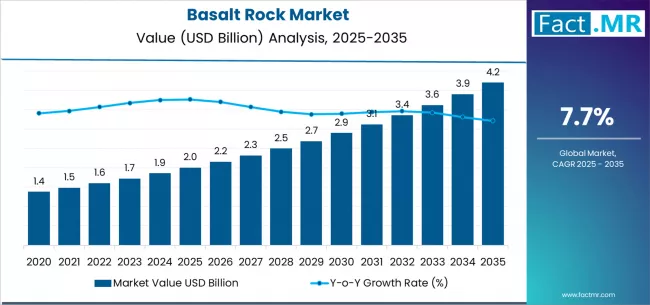
The construction and automotive sectors face mounting pressure to reduce carbon footprints and improve material performance while meeting evolving environmental regulations and structural durability requirements, with modern basalt products providing documented strength-to-weight advantages and superior corrosion resistance characteristics compared to traditional steel reinforcement and glass fiber alternatives.
Rising infrastructure investment and expanding composite material adoption across emerging economies create substantial opportunities for basalt processors and downstream manufacturers. However, limited production capacity and relatively higher costs compared to conventional materials may pose obstacles to widespread market penetration.
The basalt fiber segment dominates market activity with approximately 53.0% share in 2025, driven by the extensive application base preferring high-performance reinforcement solutions with proven mechanical properties across composite manufacturing, construction reinforcement, and automotive component applications worldwide. Material engineers increasingly recognize the technical advantages of basalt fiber, with typical product offerings providing effective tensile strength and thermal stability at optimal processing compatibility through established continuous fiber production processes.
The basalt aggregates segment demonstrates substantial presence with 27.0% share, supported by rising infrastructure construction and road building activities driving preference for durable aggregate materials and volcanic rock utilization in modern civil engineering.
Continuous fiber emerges as the critical subsegment with a 48.0% share within basalt fiber applications, reflecting industry emphasis on composite reinforcement and technical textile production for high-performance structural applications. Building and construction applications represent the dominant end-use segment with 35.5% share, driven by concrete reinforcement requirements and architectural cladding needs across diverse construction project types.
Regional dynamics show Asia Pacific maintaining market leadership, supported by massive infrastructure construction programs and expanding composite manufacturing capabilities across China, India, and developing Asian markets. Europe demonstrates strong sustainability focus driven by green building regulations and composite material innovation in automotive and wind energy sectors, while North America emphasizes infrastructure modernization and advanced composite development.
China leads country-level growth at 8.9% CAGR through strong fiber and composites production expansion, followed by India at 8.4% supported by fast infrastructure and construction sector growth.
The competitive landscape features moderate concentration with Kamenny Vek holding a 12.0% market share, while established players including Mafic SA, Technobasalt Invest LLC, and Basaltex NV compete through comprehensive product portfolios and advanced fiber processing capabilities across diverse industrial applications.
Basalt Rock Market Year-over-Year Forecast 2025 to 2035
Between 2025 and 2029, the basalt rock market is projected to expand from USD 2.0 billion to USD 2.6 billion, resulting in a value increase of USD 0.6 billion, which represents 27.3% of the total forecast growth for the period. This phase of development will be shaped by rising demand for sustainable construction materials in infrastructure projects, expanding adoption of basalt fiber reinforced composites in automotive lightweighting applications, as well as growing integration with wind turbine blade manufacturing and renewable energy component production. Companies are establishing competitive positions through investment in continuous fiber production facilities, chopped fiber processing capabilities, and strategic partnerships across composite manufacturers, construction materials suppliers, and automotive component producers.
From 2029 to 2035, the market is forecast to grow from USD 2.6 billion to USD 4.2 billion, adding another USD 1.6 billion, which constitutes 72.7% of the overall expansion. This period is expected to be characterized by the expansion of specialized product applications, including technical textiles for geotextile reinforcement and ultra-high-performance concrete formulations tailored for specific structural engineering requirements, strategic collaborations between basalt fiber producers and composite material developers, and an enhanced focus on circular economy integration and volcanic resource optimization. The growing emphasis on carbon emission reduction in construction and rising adoption of basalt rebar alternatives will drive demand for comprehensive basalt rock solutions across diverse industrial applications.
Basalt Rock Market Key Takeaways
| Metric | Value |
|---|---|
| Market Value (2025) | USD 2.0 billion |
| Market Forecast Value (2035) | USD 4.2 billion |
| Forecast CAGR (2025-2035) | 7.7% |
Why is the Basalt Rock Market Growing?
The basalt rock market grows by enabling construction engineers and composite manufacturers to achieve superior material performance and environmental sustainability while accessing naturally occurring volcanic rock resources without substantial processing complexity requirements. Infrastructure developers and automotive designers face mounting pressure to reduce embodied carbon and improve structural durability while managing diverse application specifications across load-bearing requirements and environmental exposure conditions, with modern basalt products typically providing superior tensile strength and corrosion resistance compared to steel reinforcement and glass fiber alternatives, making material substitution essential for lifecycle performance optimization positioning.
The construction industry's need for crack-resistant concrete reinforcement and the composites sector's demand for lightweight high-strength materials create comprehensive market opportunities for basalt fiber solutions that can provide reliable mechanical properties, maintain dimensional stability, and ensure predictable performance without compromising structural safety or long-term durability requirements. Government initiatives promoting sustainable construction practices and infrastructure resilience drive adoption in building projects, transportation infrastructure development, and renewable energy installations, where material choices have direct impact on project longevity and environmental footprint.
The global push toward carbon emission reduction in construction and manufacturing has created structural demand growth for natural fiber alternatives, supporting sustained consumption of basalt products across all industrial sectors. Rising awareness of basalt's superior fire resistance and chemical stability enables specification in demanding applications with extreme operating conditions and safety requirements. However, production capacity constraints affecting basalt fiber availability and cost premium considerations compared to conventional glass fiber may limit market penetration among price-sensitive applications and high-volume commodity construction projects.
Segmental Analysis
The market is segmented by product type, end use, and region. By product type, the market is divided into basalt fiber, basalt aggregates, basalt tiles and slabs, and others. Based on end use, the market is categorized into building and construction, infrastructure, automotive and transportation, energy and power, and others. Regionally, the market is divided into Asia Pacific, Europe, North America, Latin America, and Middle East & Africa.
By Product Type, Which Segment Accounts for the Dominant Market Share?
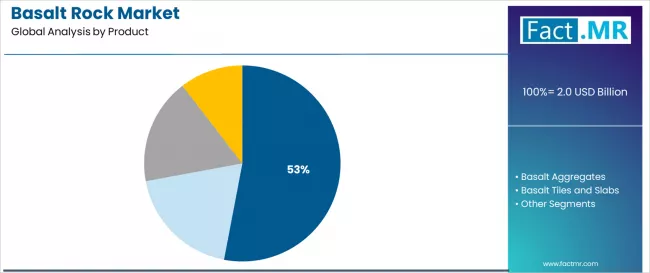
The basalt fiber segment represents the dominant force in the basalt rock market, capturing 53.0% of the total market share in 2025. This high-performance product category encompasses solutions featuring proven mechanical strength characteristics and thermal stability properties, including continuous fiber rovings and chopped fiber reinforcements that enable superior composite performance and structural enhancement across polymer matrix composites, concrete reinforcement, and technical textile applications worldwide.
The basalt fiber segment's market leadership stems from its technical advantages, with products capable of addressing demanding engineering requirements while maintaining natural origin credentials and established processing compatibility across all composite manufacturing platforms.
The basalt aggregates segment maintains a substantial 27.0% market share, serving infrastructure contractors who require durable crushed stone materials with enhanced mechanical properties for road construction, concrete production, and railway ballast applications in civil engineering projects.
These materials offer natural volcanic origin and proven performance characteristics while providing sufficient structural integrity to meet contemporary construction standards. The basalt aggregates segment demonstrates consistent market significance, driven by expanding infrastructure investment and increasing recognition of basalt's superior properties compared to conventional limestone aggregates.
Within the basalt fiber segment, continuous fiber products command approximately 48.0% subsegment share, driven by composite manufacturer preference for unidirectional reinforcement where continuous basalt fiber provides optimal tensile properties in structural composite applications. This subsegment benefits from established production technologies and proven suitability for pultrusion, filament winding, and weaving processes across industrial composite manufacturing.
Key technological advantages driving the basalt fiber segment include:
- Advanced mechanical properties with natural volcanic origin that enhance tensile strength and ensure superior temperature resistance performance
- Established production processes allowing continuous fiber manufacture across different linear densities without extensive chemical processing requirements
- Enhanced environmental credentials enabling sustainable composite production while maintaining performance equivalence to synthetic reinforcement materials
- Superior chemical resistance providing optimal durability for various corrosive environments and infrastructure applications across multiple exposure conditions
By End Use, Which Segment Accounts for the Largest Market Share?
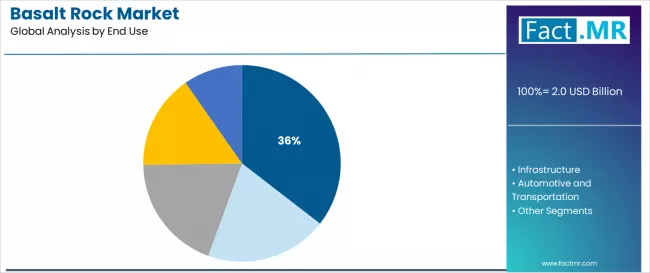
Building and construction applications dominate the basalt rock utilization landscape with approximately 35.5% market share in 2025, reflecting the critical role of basalt materials in supporting structural reinforcement and architectural applications across residential and commercial construction markets worldwide.
The building and construction segment's market leadership is reinforced by engineer preferences for corrosion-resistant reinforcement, proven fire resistance characteristics, and natural stone aesthetics combined with superior mechanical properties in demanding construction environments.
Within this segment, aggregates represent approximately 40.0% subsegment share, driven by contractor preference for high-quality crushed stone where basalt aggregates provide exceptional wearing resistance in concrete and asphalt applications. This subsegment benefits from established construction specifications and proven performance across structural concrete and road surfacing projects.
The infrastructure segment represents a substantial end-use category with 29.0% share, demonstrating strong utilization through specialized requirements for transportation infrastructure, bridge construction, and tunnel lining in civil engineering applications. This segment benefits from basalt's superior durability characteristics that ensure extended service life across demanding infrastructure environments.
The automotive and transportation segment maintains meaningful presence with 18.0% share through lightweight composite applications and vehicle component reinforcement, while energy and power accounts for 10.0% serving wind turbine blade manufacturing and electrical insulation applications.
Key market dynamics supporting end-use growth include:
- Construction sector expansion driven by urbanization trends, requiring durable reinforcement materials in building development
- Infrastructure modernization trends require high-performance aggregates for transportation network upgrades and resilient construction
- Integration of lightweight composites enabling fuel efficiency improvements and emission reduction across automotive manufacturing
- Growing emphasis on renewable energy infrastructure driving specification of basalt fiber in wind turbine components without traditional glass fiber limitations
What are the Drivers, Restraints, and Key Trends of the Basalt Rock Market?
The market is driven by three concrete demand factors tied to performance outcomes. First, increasing infrastructure investment and transportation network modernization create surging demand for high-performance construction materials, with basalt products offering superior durability and lifecycle performance worldwide, requiring expanded production capacity. Second, automotive lightweighting mandates and composite material adoption drive increased consumption of basalt fiber reinforcements, with electric vehicle manufacturers establishing composite-intensive vehicle architectures requiring natural fiber alternatives to reduce environmental impact by 2030. Third, technological advancements in continuous fiber production and surface treatment chemistry enable more cost-effective basalt fiber manufacturing that improves economic viability while reducing processing complexity and production waste.
Market restraints include limited production capacity and geographic concentration of basalt fiber manufacturing facilities that can challenge supply availability, particularly during demand surges where capacity constraints limit market responsiveness and delivery lead times prove problematic. Cost premium compared to conventional glass fiber reinforcement poses another significant challenge, as basalt fiber production involves specialized equipment and processing expertise, potentially affecting adoption rates in cost-sensitive composite applications and commodity construction markets. Technical awareness limitations among end-users regarding basalt material properties create additional market development requirements, demanding comprehensive education initiatives and application development support programs.
Key trends indicate accelerated adoption in wind energy applications across developed markets, particularly Europe and North America, where composite manufacturers demonstrate preference for natural fiber reinforcements in turbine blade production seeking improved sustainability profiles. Infrastructure resilience emphasis trends toward basalt rebar utilization with superior corrosion resistance enabling extended bridge deck service life and reduced maintenance requirements in coastal and deicing salt environments. However, the market thesis could face disruption if significant advances in carbon fiber cost reduction or breakthrough innovations in bio-based composite reinforcements reduce competitive advantages for basalt fiber in high-performance applications.
Analysis of the Basalt Rock Market by Key Countries
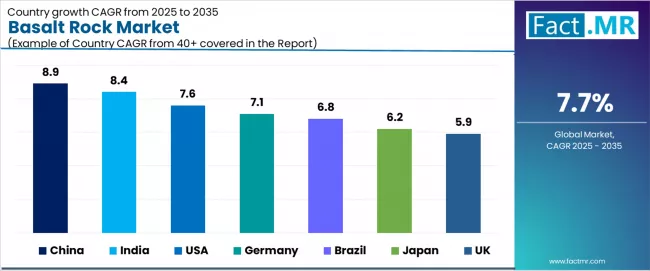
| Country | CAGR (2025-2035) |
|---|---|
| China | 8.9% |
| India | 8.4% |
| usa | 7.6% |
| Germany | 7.1% |
| Brazil | 6.8% |
| Japan | 6.2% |
| UK | 5.9% |
The global basalt rock market is expanding steadily, with China leading at an 8.9% CAGR through 2035, driven by strong fiber and composites production expansion across industrial manufacturing sectors. India follows at 8.4%, supported by fast infrastructure and construction sector growth with extensive road building programs.
usa records 7.6%, reflecting infrastructure bill impact and composite material development initiatives. Germany advances at 7.1%, leveraging sustainability-led growth and automotive composite innovation.
Brazil posts 6.8%, focusing on expanding construction sector, while Japan grows steadily at 6.2%, emphasizing infrastructure modernization. UK maintains 5.9%, supported by green building adoption and sustainable construction practices.
How is China Leading Global Market Expansion?
China demonstrates the strongest growth potential in the basalt rock market with a CAGR of 8.9% through 2035. The country's leadership position stems from massive infrastructure construction programs, expanding composite manufacturing capabilities, and government support for advanced material development driving basalt fiber production scale-up across industrial zones.
Growth is concentrated in major manufacturing provinces and infrastructure development regions, including Inner Mongolia, Sichuan, Jiangsu, and Zhejiang, where producers are establishing continuous fiber production lines for composite reinforcement and expanding basalt aggregate quarrying for transportation infrastructure projects.
Distribution channels through material trading networks and direct industrial relationships expand product accessibility across composite manufacturers and construction contractors. The country's integrated industrial ecosystem from basalt mining through fiber processing and downstream composite fabrication provides strong momentum for basalt rock category expansion, including comprehensive domestic production and application development.
Key market factors:
- Composite manufacturing expansion concentrated in industrial zones with basalt fiber reinforced polymer production for automotive and industrial applications
- Infrastructure construction programs through government investment requiring high-performance aggregates and concrete reinforcement materials
- Comprehensive production capacity, including domestic basalt fiber manufacturers with proven continuous fiber production capabilities
- Technology development featuring companies like Mudanjiang Basalt Fiber Co. and Shanxi Basalt Fiber Tech offering competitive material solutions
Why is India Emerging as a High-Growth Market?
In major infrastructure development regions including Uttar Pradesh, Maharashtra, Gujarat, and Tamil Nadu, the adoption of basalt rock materials is accelerating across road construction and building applications, driven by extensive government infrastructure programs and construction sector modernization.
The market demonstrates strong growth momentum with a CAGR of 8.4% through 2035, linked to comprehensive road network expansion and increasing focus on durable construction materials with extended service life characteristics.
Indian contractors are implementing basalt aggregates for highway construction and exploring basalt fiber reinforcement for infrastructure applications to improve project durability while supporting domestic material sourcing objectives.
The country's massive infrastructure investment creates ongoing demand for high-performance construction materials, while growing awareness of basalt properties drives specification in demanding civil engineering applications.
Key development areas:
- Road construction programs and infrastructure projects leading basalt aggregate adoption with emphasis on pavement durability
- Government infrastructure initiatives supporting domestic material development and advanced construction technology adoption
- Construction material innovation enabling basalt product integration and performance validation in tropical climate conditions
- Growing specification of corrosion-resistant reinforcement driving interest in basalt rebar alternatives for coastal infrastructure
What drives USA Market Resilience?
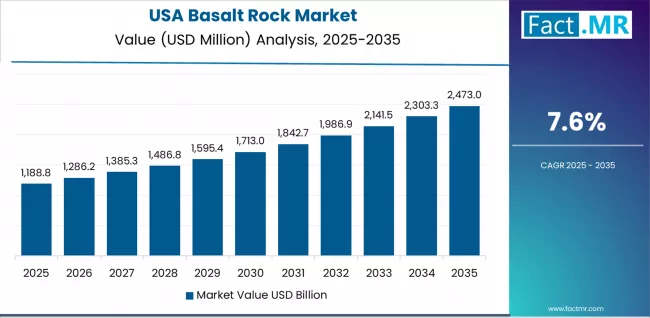
usa’s market expansion is driven by Infrastructure Investment and Jobs Act funding supporting transportation network modernization and bridge rehabilitation requiring durable construction materials and corrosion-resistant reinforcement. The country demonstrates steady growth potential with a CAGR of 7.6% through 2035, supported by continuous composite material innovation and established research programs advancing basalt fiber applications.
American infrastructure agencies face implementation challenges related to material specification approval and long-term performance validation requiring comprehensive testing and demonstration projects. Established composite manufacturing expertise and growing sustainability emphasis create stable baseline demand for basalt fiber products, particularly in wind energy applications where natural fiber reinforcements drive primary material selection in turbine blade manufacturing.
Market characteristics:
- Infrastructure and composite segments showing robust demand with substantial basalt fiber content in wind energy and transportation applications
- Regional material availability varying between western volcanic deposits and eastern composite manufacturing concentrations
- Future projections indicate continued infrastructure investment with emphasis on resilient materials and extended service life solutions
- Growing emphasis on domestic production capacity and supply chain development supporting strategic material security objectives
How does Germany Demonstrate Composite Innovation Leadership?
The market in Germany leads in automotive composite applications based on integration with lightweight vehicle development and advanced manufacturing technologies supporting sustainable mobility solutions. The country shows strong potential with a CAGR of 7.1% through 2035, driven by automotive industry transformation and sustainability mandates in major regions, including Bavaria, Baden-Württemberg, North Rhine-Westphalia, and Lower Saxony.
German automotive suppliers are specifying basalt fiber reinforcements for structural components and exploring natural fiber composites to reduce vehicle carbon footprint while meeting performance requirements. Distribution channels through composite material distributors and direct automotive supply relationships expand basalt fiber accessibility across tier suppliers and component manufacturers.
Leading market segments:
- Automotive composite adoption in major manufacturing regions implementing lightweight material strategies for electric vehicle platforms
- Wind energy applications with established turbine blade manufacturing utilizing basalt fiber reinforcement
- Strategic partnerships between basalt fiber producers and composite manufacturers achieving technical qualification and performance validation
- Focus on sustainability credentials and life cycle assessment supporting natural fiber preference in environmental product declarations
What Positions UK for Sustainable Construction?
In major cities including London, Manchester, Birmingham, and Leeds, construction projects are implementing sustainable building materials featuring basalt products and natural fiber reinforcements, with documented specification trends showing substantial interest through green building certification programs and environmental responsibility commitments. The market shows moderate growth potential with a CAGR of 5.9% through 2035, linked to ongoing green building adoption, infrastructure resilience emphasis, and sustainable material preferences in major regions.
Contractors are exploring basalt aggregate utilization and specifying basalt fiber reinforced concrete for durability enhancement while supporting carbon reduction objectives. The country's building regulation evolution creates ongoing opportunities for innovative construction materials that differentiate through environmental performance and structural benefits.
Market development factors:
- Green building projects in major urban areas leading adoption of sustainable construction materials including basalt products
- Infrastructure resilience programs providing opportunities for corrosion-resistant reinforcement and durable aggregates
- Strategic focus on embodied carbon reduction and natural material utilization in construction industry transformation
- Emphasis on performance validation and building code approval supporting basalt material specification development
How does Brazil Show Infrastructure Development?
In major infrastructure regions including São Paulo, Minas Gerais, Rio de Janeiro, and Paraná, the adoption of basalt rock materials is expanding across road construction and building applications, driven by infrastructure investment programs and construction sector growth. The market demonstrates moderate growth potential with a CAGR of 6.8% through 2035, linked to transportation network expansion and increasing urbanization supporting construction material demand.
Brazilian contractors are implementing basalt aggregates for highway construction and considering fiber reinforced concrete for infrastructure durability enhancement in tropical climate conditions. The country's volcanic geology creates opportunities for basalt resource development, while expanding construction activity drives specification of high-performance construction materials.
Key development areas:
- Road construction projects in major corridors leading basalt aggregate consumption with emphasis on pavement performance
- Infrastructure investment programs supporting material innovation and advanced construction technology adoption
- Construction sector modernization driving specification of durable materials and performance-enhanced concrete formulations
- Resource development initiatives enabling domestic basalt production and local material supply chain establishment
What Characterizes Japan's Market Development?
The Japan market demonstrates infrastructure modernization focus based on aging infrastructure replacement and seismic resilience enhancement requiring high-performance construction materials. The country shows moderate growth potential with a CAGR of 6.2% through 2035, driven by comprehensive infrastructure maintenance programs and advanced material adoption in major regions, including Tokyo, Osaka, Nagoya, and Fukuoka.
Japanese engineers are evaluating basalt fiber reinforcement for seismic retrofitting and implementing corrosion-resistant materials for coastal infrastructure extending service life in harsh marine environments. Distribution channels through construction material suppliers and engineering consultancy relationships expand basalt product awareness across infrastructure agencies and construction contractors.
Leading market segments:
- Infrastructure modernization in major urban areas implementing advanced materials for bridge rehabilitation and tunnel reinforcement
- Seismic resilience applications with fiber reinforced concrete and structural strengthening systems
- Strategic emphasis on durability and lifecycle cost optimization addressing aging infrastructure challenges
- Coastal infrastructure protection requiring corrosion-resistant reinforcement and durable construction materials
Europe Market Split by Country
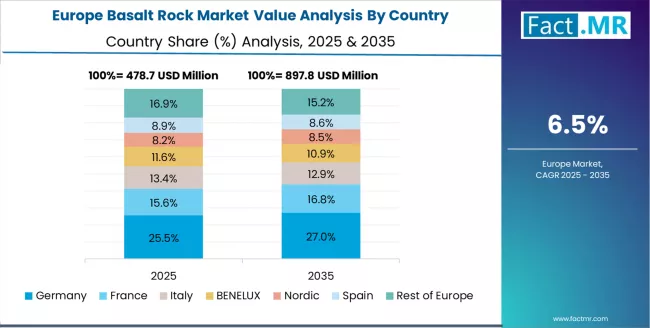
The basalt rock market in Europe is projected to grow from USD 0.6 billion in 2025 to USD 1.2 billion by 2035, registering a CAGR of 7.2% over the forecast period. Germany is expected to maintain its leadership position with a 28.5% market share in 2025, adjusting slightly to 28.2% by 2035, supported by its advanced automotive composite industry, renewable energy manufacturing capabilities, and comprehensive sustainable construction initiatives serving major European markets.
France follows with a 21.0% share in 2025, projected to reach 21.3% by 2035, driven by infrastructure investment programs in major regions and wind energy development initiatives. UK holds a 19.5% share in 2025, expected to maintain 19.3% by 2035 through ongoing green building adoption and sustainable construction material development.
Italy commands a 15.0% share, while Spain accounts for 12.5% in 2025. The rest of Europe region is anticipated to gain momentum, expanding its collective share from 3.5% to 3.7% by 2035, attributed to increasing basalt rock adoption in Nordic countries and emerging Eastern European markets implementing infrastructure modernization programs.
How does Advanced Manufacturing Define Basalt Rock Adoption in Japan?
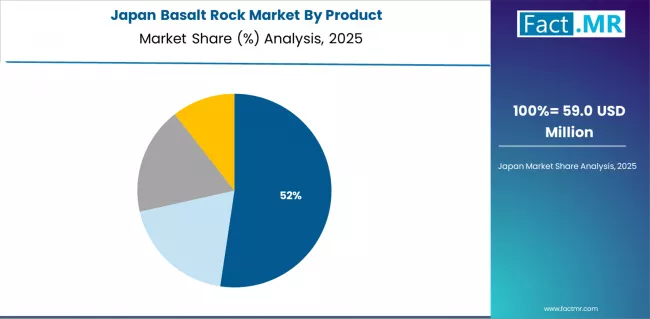
The Japanese basalt rock market demonstrates a mature and performance-focused landscape, characterized by sophisticated integration of advanced material evaluation with stringent quality requirements across infrastructure applications, composite manufacturing, and construction projects. Japan's emphasis on seismic resilience and durability optimization drives demand for high-performance reinforcement materials that support comprehensive infrastructure protection initiatives and lifecycle cost reduction in challenging environmental conditions.
The market benefits from strong partnerships between international basalt fiber producers, domestic material distributors, and established construction and composite companies, creating comprehensive evaluation ecosystems that prioritize technical validation and performance verification programs. Infrastructure modernization projects showcase advanced basalt material implementations where fiber reinforcement achieves structural enhancement improvements through integrated engineering assessment systems and rigorous quality control protocols.
What drives Material Innovation in South Korea's Market?
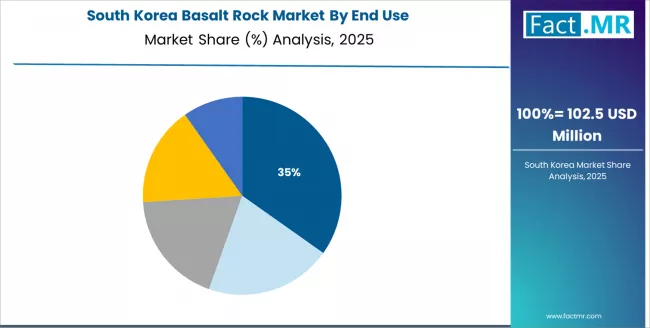
The South Korean basalt rock market is characterized by growing composite industry development, with companies like domestic fiber producers and international suppliers maintaining material development programs through technical collaboration and application engineering for automotive and industrial applications.
The market is demonstrating an increasing emphasis on lightweight composite materials and sustainable manufacturing, as Korean manufacturers increasingly demand natural fiber reinforcements that combine mechanical performance with environmental credentials and processing compatibility deployed across automotive component production and industrial equipment manufacturing.
Local material innovation initiatives and research institution partnerships are supporting market development through strategic emphasis on application optimization, offering specialized processing techniques including surface treatment protocols and sizing formulations for comprehensive composite system integration.
The competitive landscape shows increasing collaboration between basalt fiber producers and composite manufacturers, creating technical development models that combine material science expertise with application engineering capabilities and quality management systems.
Competitive Landscape of the Basalt Rock Market
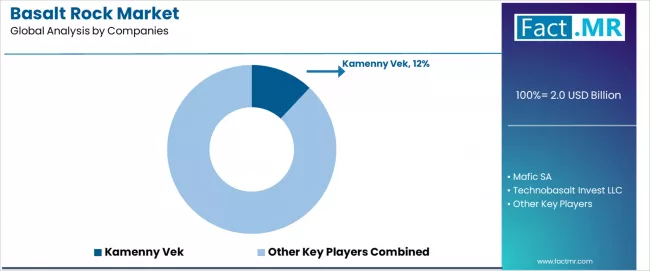
The basalt rock market features approximately 15-20 meaningful players with moderate concentration, where the top three companies control roughly 30-35% of global market share through established production facilities and technical capabilities. Competition centers on fiber quality, production capacity, and technical support rather than price competition alone.
Market leaders include Kamenny Vek, Mafic SA, and Technobasalt Invest LLC, which maintain competitive advantages through comprehensive basalt fiber product portfolios, continuous production technologies, and deep expertise in volcanic rock processing, creating strong customer relationships and technical credibility. These companies leverage established manufacturing operations and ongoing research initiatives to defend market positions while expanding into adjacent applications including technical textiles and specialized composite reinforcements.
Challengers encompass Basaltex NV and Mudanjiang Basalt Fiber Co., which compete through specialized product development and strong market presence in key European and Asian composite markets. Material processing specialists, including Shanxi Basalt Fiber Tech, Galen Ltd, and Deutsche Basalt Faser GmbH, focus on specific fiber formats or regional markets, offering differentiated capabilities in chopped fiber production, woven fabrics, and custom fiber specifications.
Regional producers and emerging basalt companies create competitive pressure through localized resource access and niche application development, particularly in high-growth markets including China and India, where volcanic resource availability provides advantages in raw material costs and production economics.
Market dynamics favor companies that combine advanced fiber processing technologies with comprehensive technical support capabilities that address the complete value chain from rock quarrying through finished fiber production and application development services. Strategic emphasis on continuous fiber quality consistency, surface treatment optimization, and composite system integration enables differentiation in increasingly performance-driven material selection decisions across construction, automotive, and industrial composite sectors.
Global Basalt Rock Market -- Stakeholder Contribution Framework
Basalt rock products represent critical advanced materials that enable construction engineers, composite manufacturers, and infrastructure developers to achieve superior structural performance and environmental sustainability without compromising mechanical integrity, typically providing enhanced tensile strength and corrosion resistance capabilities compared to steel reinforcement and glass fiber alternatives while ensuring reliable long-term durability and natural material origin. With the market projected to grow from USD 2.0 billion in 2025 to USD 4.2 billion by 2035 at a 7.7% CAGR, these products offer compelling advantages - proven mechanical properties, superior environmental resistance, and sustainable volcanic origin - making them essential for building and construction applications (35.5% end-use share), basalt fiber products (53.0% product share), and diverse industrial sectors seeking high-performance natural materials. Scaling market development and application expansion requires coordinated action across resource development, processing capacity investment, composite manufacturers, end-users, and technical education initiatives.
How Could Governments Spur Local Development and Adoption?
- Resource Development Programs: Include basalt deposits in mineral resource assessments, provide exploration support for volcanic rock reserves, and establish geological mapping programs identifying commercial-grade basalt formations for industrial development.
- Infrastructure Investment & Standards: Fund demonstration projects utilizing basalt reinforcement and aggregates, establish material specifications for transportation infrastructure applications, and create performance testing protocols validating basalt product suitability in building codes.
- Industrial Policy Support: Provide capital investment incentives for basalt fiber production facilities, support technology transfer programs advancing continuous fiber manufacturing, and establish preferential procurement policies for infrastructure projects utilizing sustainable materials.
- Research & Innovation Funding: Support university research programs on basalt composite development, fund material characterization studies validating performance properties, and invest in application development initiatives demonstrating basalt advantages in demanding engineering applications.
- Sustainable Construction Initiatives: Establish embodied carbon regulations favoring natural materials, create green building incentive programs recognizing basalt utilization, and develop circular economy frameworks supporting volcanic resource optimization and extended material lifecycles.
How Could Industry Bodies Support Market Development?
- Technical Standards & Specifications: Define standardized material properties for basalt fiber and aggregates across construction and composite applications, establish universal testing methodologies for mechanical and durability characteristics, and create specification frameworks ensuring product quality consistency.
- Application Guidelines: Lead technical education demonstrating basalt material advantages, emphasizing superior corrosion resistance, thermal stability benefits, and environmental credentials compared to conventional reinforcement alternatives.
- Performance Validation: Develop certification programs for basalt fiber producers, establish quality assurance protocols, and create long-term performance databases supporting material specification decisions and building code acceptance.
- Professional Development: Run training programs for structural engineers, composite designers, and construction professionals on optimizing basalt material selection, processing techniques, and application best practices in competitive material markets.
How Could Manufacturers and Processors Strengthen the Ecosystem?
- Production Capacity Development: Expand continuous fiber production capabilities, invest in chopped fiber processing systems, and establish aggregate quarrying operations that reduce supply constraints through increased manufacturing capacity.
- Technical Development Programs: Develop specialized fiber sizing formulations optimizing composite integration, create application-specific products for targeted markets, and establish technical support resources helping customers optimize material selection and processing parameters.
- Quality Management Systems: Implement comprehensive fiber testing protocols, achieve international quality certifications including ISO standards, and provide material property documentation supporting customer qualification and regulatory approval requirements.
- Market Development Initiatives: Conduct demonstration projects validating basalt performance, partner with research institutions on application development, and provide sample materials supporting customer evaluation and specification development programs.
How Could End-Users and Specifiers Navigate the Market?
- Material Selection Strategies: Evaluate basalt fiber applications (53.0% product dominance) and aggregates for construction projects, with particular focus on corrosion-prone infrastructure and high-performance composite requirements.
- Geographic Sourcing Priorities: Establish material relationships in high-growth markets like China (8.9% CAGR) and India (8.4% CAGR), while accessing established suppliers in developed markets like USA (7.6% CAGR) and Germany (7.1% CAGR) through diversified procurement strategies.
- Technical Collaboration: Partner with basalt fiber producers on composite system development, participate in material testing programs, and provide application feedback enabling continuous product improvement aligned with evolving performance requirements.
- Lifecycle Assessment: Evaluate total cost of ownership including extended service life benefits, reduced maintenance requirements, and sustainability credentials supporting project environmental objectives and long-term value optimization.
How Could Investors and Financial Enablers Unlock Value?
- Production Capacity Financing: Provide growth capital for established companies like Kamenny Vek, Mafic SA, and Technobasalt Invest LLC to expand fiber production facilities and geographic presence, particularly in emerging markets with growing composite demand.
- Technology Investment: Back companies developing advanced fiber production technologies, surface treatment innovations, and processing automation systems that enhance manufacturing efficiency and product capabilities.
- Resource Development: Finance basalt quarry development, support integrated production facilities combining mining and fiber processing, and enable vertical integration creating mine-to-market value chains.
- Market Development Support: Fund application development programs, support technical marketing initiatives, and enable demonstration projects validating basalt performance in target applications and building market awareness across engineering communities.
Key Players in the Basalt Rock Market
- Kamenny Vek
- Mafic SA
- Technobasalt Invest LLC
- Basaltex NV
- Mudanjiang Basalt Fiber Co.
- Shanxi Basalt Fiber Tech
- Galen Ltd
- Deutsche Basalt Faser GmbH
- Jumeisheng
- Aravali India Marbles & Granites
Scope of the Report
| Items | Values |
|---|---|
| Quantitative Units | USD 2.0 Billion |
| Product Type | Basalt Fiber, Basalt Aggregates, Basalt Tiles and Slabs, Others |
| End Use | Building and Construction, Infrastructure, Automotive and Transportation, Energy and Power, Others |
| Regions Covered | Asia Pacific, Europe, North America, Latin America, Middle East & Africa |
| Country Covered | China, India, USA, Germany, Brazil, Japan, UK, and 40+ countries |
| Key Companies Profiled | Kamenny Vek, Mafic SA, Technobasalt Invest LLC, Basaltex NV, Mudanjiang Basalt Fiber Co., Shanxi Basalt Fiber Tech, Galen Ltd, Deutsche Basalt Faser GmbH, Jumeisheng, Aravali India Marbles & Granites |
| Additional Attributes | Dollar sales by product type and end-use categories, regional adoption trends across Asia Pacific, Europe, and North America, competitive landscape with basalt processors and composite material companies, product specifications and mechanical property requirements, integration with sustainable construction initiatives and composite lightweighting programs, innovations in continuous fiber production technology and surface treatment systems, and development of specialized applications with infrastructure reinforcement and automotive composite capabilities. |
Basalt Rock Market by Segments
-
Product Type :
- Basalt Fiber
- Continuous Fiber
- Chopped Fiber
- Fabric and Textiles
- Basalt Aggregates
- Basalt Tiles and Slabs
- Others
- Basalt Fiber
-
End Use :
- Building and Construction
- Aggregates
- Tiles and Slabs
- Rebar
- Insulation Materials
- Infrastructure
- Automotive and Transportation
- Energy and Power
- Others
- Building and Construction
-
Region :
- Asia Pacific
- China
- Japan
- South Korea
- India
- Australia & New Zealand
- ASEAN
- Rest of Asia Pacific
- Europe
- Germany
- UK
- France
- Italy
- Spain
- Nordic
- BENELUX
- Rest of Europe
- North America
- usa
- Canada
- Mexico
- Latin America
- Brazil
- Chile
- Rest of Latin America
- Middle East & Africa
- Kingdom of Saudi Arabia
- Other GCC Countries
- Turkey
- South Africa
- Other African Union
- Rest of Middle East & Africa
- Asia Pacific
Table of Content
- Executive Summary
- Global Market Outlook
- Demand to side Trends
- Supply to side Trends
- Technology Roadmap Analysis
- Analysis and Recommendations
- Market Overview
- Market Coverage / Taxonomy
- Market Definition / Scope / Limitations
- Market Background
- Market Dynamics
- Drivers
- Restraints
- Opportunity
- Trends
- Scenario Forecast
- Demand in Optimistic Scenario
- Demand in Likely Scenario
- Demand in Conservative Scenario
- Opportunity Map Analysis
- Product Life Cycle Analysis
- Supply Chain Analysis
- Investment Feasibility Matrix
- Value Chain Analysis
- PESTLE and Porter’s Analysis
- Regulatory Landscape
- Regional Parent Market Outlook
- Production and Consumption Statistics
- Import and Export Statistics
- Market Dynamics
- Global Market Analysis 2020 to 2024 and Forecast, 2025 to 2035
- Historical Market Size Value (USD Million) Analysis, 2020 to 2024
- Current and Future Market Size Value (USD Million) Projections, 2025 to 2035
- Y to o to Y Growth Trend Analysis
- Absolute $ Opportunity Analysis
- Global Market Pricing Analysis 2020 to 2024 and Forecast 2025 to 2035
- Global Market Analysis 2020 to 2024 and Forecast 2025 to 2035, By Product
- Introduction / Key Findings
- Historical Market Size Value (USD Million) Analysis By Product, 2020 to 2024
- Current and Future Market Size Value (USD Million) Analysis and Forecast By Product, 2025 to 2035
- Basalt Fiber
- Basalt Aggregates
- Basalt Tiles and Slabs
- Others
- Y to o to Y Growth Trend Analysis By Product, 2020 to 2024
- Absolute $ Opportunity Analysis By Product, 2025 to 2035
- Global Market Analysis 2020 to 2024 and Forecast 2025 to 2035, By End Use
- Introduction / Key Findings
- Historical Market Size Value (USD Million) Analysis By End Use, 2020 to 2024
- Current and Future Market Size Value (USD Million) Analysis and Forecast By End Use, 2025 to 2035
- Building and Construction
- Infrastructure
- Automotive and Transportation
- Energy and Power
- Others
- Y to o to Y Growth Trend Analysis By End Use, 2020 to 2024
- Absolute $ Opportunity Analysis By End Use, 2025 to 2035
- Global Market Analysis 2020 to 2024 and Forecast 2025 to 2035, By Region
- Introduction
- Historical Market Size Value (USD Million) Analysis By Region, 2020 to 2024
- Current Market Size Value (USD Million) Analysis and Forecast By Region, 2025 to 2035
- North America
- Latin America
- Western Europe
- Eastern Europe
- East Asia
- South Asia and Pacific
- Middle East & Africa
- Market Attractiveness Analysis By Region
- North America Market Analysis 2020 to 2024 and Forecast 2025 to 2035, By Country
- Historical Market Size Value (USD Million) Trend Analysis By Market Taxonomy, 2020 to 2024
- Market Size Value (USD Million) Forecast By Market Taxonomy, 2025 to 2035
- By Country
- USA
- Canada
- Mexico
- By Product
- By End Use
- By Country
- Market Attractiveness Analysis
- By Country
- By Product
- By End Use
- Key Takeaways
- Latin America Market Analysis 2020 to 2024 and Forecast 2025 to 2035, By Country
- Historical Market Size Value (USD Million) Trend Analysis By Market Taxonomy, 2020 to 2024
- Market Size Value (USD Million) Forecast By Market Taxonomy, 2025 to 2035
- By Country
- Brazil
- Chile
- Rest of Latin America
- By Product
- By End Use
- By Country
- Market Attractiveness Analysis
- By Country
- By Product
- By End Use
- Key Takeaways
- Western Europe Market Analysis 2020 to 2024 and Forecast 2025 to 2035, By Country
- Historical Market Size Value (USD Million) Trend Analysis By Market Taxonomy, 2020 to 2024
- Market Size Value (USD Million) Forecast By Market Taxonomy, 2025 to 2035
- By Country
- Germany
- UK
- Italy
- Spain
- France
- Nordic
- BENELUX
- Rest of Western Europe
- By Product
- By End Use
- By Country
- Market Attractiveness Analysis
- By Country
- By Product
- By End Use
- Key Takeaways
- Eastern Europe Market Analysis 2020 to 2024 and Forecast 2025 to 2035, By Country
- Historical Market Size Value (USD Million) Trend Analysis By Market Taxonomy, 2020 to 2024
- Market Size Value (USD Million) Forecast By Market Taxonomy, 2025 to 2035
- By Country
- Russia
- Poland
- Hungary
- Balkan & Baltic
- Rest of Eastern Europe
- By Product
- By End Use
- By Country
- Market Attractiveness Analysis
- By Country
- By Product
- By End Use
- Key Takeaways
- East Asia Market Analysis 2020 to 2024 and Forecast 2025 to 2035, By Country
- Historical Market Size Value (USD Million) Trend Analysis By Market Taxonomy, 2020 to 2024
- Market Size Value (USD Million) Forecast By Market Taxonomy, 2025 to 2035
- By Country
- China
- Japan
- South Korea
- By Product
- By End Use
- By Country
- Market Attractiveness Analysis
- By Country
- By Product
- By End Use
- Key Takeaways
- South Asia and Pacific Market Analysis 2020 to 2024 and Forecast 2025 to 2035, By Country
- Historical Market Size Value (USD Million) Trend Analysis By Market Taxonomy, 2020 to 2024
- Market Size Value (USD Million) Forecast By Market Taxonomy, 2025 to 2035
- By Country
- India
- ASEAN
- Australia & New Zealand
- Rest of South Asia and Pacific
- By Product
- By End Use
- By Country
- Market Attractiveness Analysis
- By Country
- By Product
- By End Use
- Key Takeaways
- Middle East & Africa Market Analysis 2020 to 2024 and Forecast 2025 to 2035, By Country
- Historical Market Size Value (USD Million) Trend Analysis By Market Taxonomy, 2020 to 2024
- Market Size Value (USD Million) Forecast By Market Taxonomy, 2025 to 2035
- By Country
- Kingdom of Saudi Arabia
- Other GCC Countries
- Turkiye
- South Africa
- Other African Union
- Rest of Middle East & Africa
- By Product
- By End Use
- By Country
- Market Attractiveness Analysis
- By Country
- By Product
- By End Use
- Key Takeaways
- Key Countries Market Analysis
- USA
- Pricing Analysis
- Market Share Analysis, 2024
- By Product
- By End Use
- Canada
- Pricing Analysis
- Market Share Analysis, 2024
- By Product
- By End Use
- Mexico
- Pricing Analysis
- Market Share Analysis, 2024
- By Product
- By End Use
- Brazil
- Pricing Analysis
- Market Share Analysis, 2024
- By Product
- By End Use
- Chile
- Pricing Analysis
- Market Share Analysis, 2024
- By Product
- By End Use
- Germany
- Pricing Analysis
- Market Share Analysis, 2024
- By Product
- By End Use
- UK
- Pricing Analysis
- Market Share Analysis, 2024
- By Product
- By End Use
- Italy
- Pricing Analysis
- Market Share Analysis, 2024
- By Product
- By End Use
- Spain
- Pricing Analysis
- Market Share Analysis, 2024
- By Product
- By End Use
- France
- Pricing Analysis
- Market Share Analysis, 2024
- By Product
- By End Use
- India
- Pricing Analysis
- Market Share Analysis, 2024
- By Product
- By End Use
- ASEAN
- Pricing Analysis
- Market Share Analysis, 2024
- By Product
- By End Use
- Australia & New Zealand
- Pricing Analysis
- Market Share Analysis, 2024
- By Product
- By End Use
- China
- Pricing Analysis
- Market Share Analysis, 2024
- By Product
- By End Use
- Japan
- Pricing Analysis
- Market Share Analysis, 2024
- By Product
- By End Use
- South Korea
- Pricing Analysis
- Market Share Analysis, 2024
- By Product
- By End Use
- Russia
- Pricing Analysis
- Market Share Analysis, 2024
- By Product
- By End Use
- Poland
- Pricing Analysis
- Market Share Analysis, 2024
- By Product
- By End Use
- Hungary
- Pricing Analysis
- Market Share Analysis, 2024
- By Product
- By End Use
- Kingdom of Saudi Arabia
- Pricing Analysis
- Market Share Analysis, 2024
- By Product
- By End Use
- Turkiye
- Pricing Analysis
- Market Share Analysis, 2024
- By Product
- By End Use
- South Africa
- Pricing Analysis
- Market Share Analysis, 2024
- By Product
- By End Use
- USA
- Market Structure Analysis
- Competition Dashboard
- Competition Benchmarking
- Market Share Analysis of Top Players
- By Regional
- By Product
- By End Use
- Competition Analysis
- Competition Deep Dive
- Kamenny Vek
- Overview
- Product Portfolio
- Profitability by Market Segments (Product/Age /Sales Channel/Region)
- Sales Footprint
- Strategy Overview
- Marketing Strategy
- Product Strategy
- Channel Strategy
- Mafic SA
- Technobasalt Invest LLC
- Basaltex NV
- Mudanjiang Basalt Fiber Co.
- Shanxi Basalt Fiber Tech
- Galen Ltd
- Deutsche Basalt Faser GmbH
- Jumeisheng
- Aravali India Marbles & Granites
- Kamenny Vek
- Competition Deep Dive
- Assumptions & Acronyms Used
- Research Methodology
List Of Table
- Table 1: Global Market Value (USD Million) Forecast by Region, 2020 to 2035
- Table 2: Global Market Value (USD Million) Forecast by Product, 2020 to 2035
- Table 3: Global Market Value (USD Million) Forecast by End Use, 2020 to 2035
- Table 4: North America Market Value (USD Million) Forecast by Country, 2020 to 2035
- Table 5: North America Market Value (USD Million) Forecast by Product, 2020 to 2035
- Table 6: North America Market Value (USD Million) Forecast by End Use, 2020 to 2035
- Table 7: Latin America Market Value (USD Million) Forecast by Country, 2020 to 2035
- Table 8: Latin America Market Value (USD Million) Forecast by Product, 2020 to 2035
- Table 9: Latin America Market Value (USD Million) Forecast by End Use, 2020 to 2035
- Table 10: Western Europe Market Value (USD Million) Forecast by Country, 2020 to 2035
- Table 11: Western Europe Market Value (USD Million) Forecast by Product, 2020 to 2035
- Table 12: Western Europe Market Value (USD Million) Forecast by End Use, 2020 to 2035
- Table 13: Eastern Europe Market Value (USD Million) Forecast by Country, 2020 to 2035
- Table 14: Eastern Europe Market Value (USD Million) Forecast by Product, 2020 to 2035
- Table 15: Eastern Europe Market Value (USD Million) Forecast by End Use, 2020 to 2035
- Table 16: East Asia Market Value (USD Million) Forecast by Country, 2020 to 2035
- Table 17: East Asia Market Value (USD Million) Forecast by Product, 2020 to 2035
- Table 18: East Asia Market Value (USD Million) Forecast by End Use, 2020 to 2035
- Table 19: South Asia and Pacific Market Value (USD Million) Forecast by Country, 2020 to 2035
- Table 20: South Asia and Pacific Market Value (USD Million) Forecast by Product, 2020 to 2035
- Table 21: South Asia and Pacific Market Value (USD Million) Forecast by End Use, 2020 to 2035
- Table 22: Middle East & Africa Market Value (USD Million) Forecast by Country, 2020 to 2035
- Table 23: Middle East & Africa Market Value (USD Million) Forecast by Product, 2020 to 2035
- Table 24: Middle East & Africa Market Value (USD Million) Forecast by End Use, 2020 to 2035
List Of Figures
- Figure 1: Global Market Pricing Analysis
- Figure 2: Global Market Value (USD Million) Forecast 2020 to 2035
- Figure 3: Global Market Value Share and BPS Analysis by Product, 2025 and 2035
- Figure 4: Global Market Y to o to Y Growth Comparison by Product, 2025 to 2035
- Figure 5: Global Market Attractiveness Analysis by Product
- Figure 6: Global Market Value Share and BPS Analysis by End Use, 2025 and 2035
- Figure 7: Global Market Y to o to Y Growth Comparison by End Use, 2025 to 2035
- Figure 8: Global Market Attractiveness Analysis by End Use
- Figure 9: Global Market Value (USD Million) Share and BPS Analysis by Region, 2025 and 2035
- Figure 10: Global Market Y to o to Y Growth Comparison by Region, 2025 to 2035
- Figure 11: Global Market Attractiveness Analysis by Region
- Figure 12: North America Market Incremental Dollar Opportunity, 2025 to 2035
- Figure 13: Latin America Market Incremental Dollar Opportunity, 2025 to 2035
- Figure 14: Western Europe Market Incremental Dollar Opportunity, 2025 to 2035
- Figure 15: Eastern Europe Market Incremental Dollar Opportunity, 2025 to 2035
- Figure 16: East Asia Market Incremental Dollar Opportunity, 2025 to 2035
- Figure 17: South Asia and Pacific Market Incremental Dollar Opportunity, 2025 to 2035
- Figure 18: Middle East & Africa Market Incremental Dollar Opportunity, 2025 to 2035
- Figure 19: North America Market Value Share and BPS Analysis by Country, 2025 and 2035
- Figure 20: North America Market Value Share and BPS Analysis by Product, 2025 and 2035
- Figure 21: North America Market Y to o to Y Growth Comparison by Product, 2025 to 2035
- Figure 22: North America Market Attractiveness Analysis by Product
- Figure 23: North America Market Value Share and BPS Analysis by End Use, 2025 and 2035
- Figure 24: North America Market Y to o to Y Growth Comparison by End Use, 2025 to 2035
- Figure 25: North America Market Attractiveness Analysis by End Use
- Figure 26: Latin America Market Value Share and BPS Analysis by Country, 2025 and 2035
- Figure 27: Latin America Market Value Share and BPS Analysis by Product, 2025 and 2035
- Figure 28: Latin America Market Y to o to Y Growth Comparison by Product, 2025 to 2035
- Figure 29: Latin America Market Attractiveness Analysis by Product
- Figure 30: Latin America Market Value Share and BPS Analysis by End Use, 2025 and 2035
- Figure 31: Latin America Market Y to o to Y Growth Comparison by End Use, 2025 to 2035
- Figure 32: Latin America Market Attractiveness Analysis by End Use
- Figure 33: Western Europe Market Value Share and BPS Analysis by Country, 2025 and 2035
- Figure 34: Western Europe Market Value Share and BPS Analysis by Product, 2025 and 2035
- Figure 35: Western Europe Market Y to o to Y Growth Comparison by Product, 2025 to 2035
- Figure 36: Western Europe Market Attractiveness Analysis by Product
- Figure 37: Western Europe Market Value Share and BPS Analysis by End Use, 2025 and 2035
- Figure 38: Western Europe Market Y to o to Y Growth Comparison by End Use, 2025 to 2035
- Figure 39: Western Europe Market Attractiveness Analysis by End Use
- Figure 40: Eastern Europe Market Value Share and BPS Analysis by Country, 2025 and 2035
- Figure 41: Eastern Europe Market Value Share and BPS Analysis by Product, 2025 and 2035
- Figure 42: Eastern Europe Market Y to o to Y Growth Comparison by Product, 2025 to 2035
- Figure 43: Eastern Europe Market Attractiveness Analysis by Product
- Figure 44: Eastern Europe Market Value Share and BPS Analysis by End Use, 2025 and 2035
- Figure 45: Eastern Europe Market Y to o to Y Growth Comparison by End Use, 2025 to 2035
- Figure 46: Eastern Europe Market Attractiveness Analysis by End Use
- Figure 47: East Asia Market Value Share and BPS Analysis by Country, 2025 and 2035
- Figure 48: East Asia Market Value Share and BPS Analysis by Product, 2025 and 2035
- Figure 49: East Asia Market Y to o to Y Growth Comparison by Product, 2025 to 2035
- Figure 50: East Asia Market Attractiveness Analysis by Product
- Figure 51: East Asia Market Value Share and BPS Analysis by End Use, 2025 and 2035
- Figure 52: East Asia Market Y to o to Y Growth Comparison by End Use, 2025 to 2035
- Figure 53: East Asia Market Attractiveness Analysis by End Use
- Figure 54: South Asia and Pacific Market Value Share and BPS Analysis by Country, 2025 and 2035
- Figure 55: South Asia and Pacific Market Value Share and BPS Analysis by Product, 2025 and 2035
- Figure 56: South Asia and Pacific Market Y to o to Y Growth Comparison by Product, 2025 to 2035
- Figure 57: South Asia and Pacific Market Attractiveness Analysis by Product
- Figure 58: South Asia and Pacific Market Value Share and BPS Analysis by End Use, 2025 and 2035
- Figure 59: South Asia and Pacific Market Y to o to Y Growth Comparison by End Use, 2025 to 2035
- Figure 60: South Asia and Pacific Market Attractiveness Analysis by End Use
- Figure 61: Middle East & Africa Market Value Share and BPS Analysis by Country, 2025 and 2035
- Figure 62: Middle East & Africa Market Value Share and BPS Analysis by Product, 2025 and 2035
- Figure 63: Middle East & Africa Market Y to o to Y Growth Comparison by Product, 2025 to 2035
- Figure 64: Middle East & Africa Market Attractiveness Analysis by Product
- Figure 65: Middle East & Africa Market Value Share and BPS Analysis by End Use, 2025 and 2035
- Figure 66: Middle East & Africa Market Y to o to Y Growth Comparison by End Use, 2025 to 2035
- Figure 67: Middle East & Africa Market Attractiveness Analysis by End Use
- Figure 68: Global Market - Tier Structure Analysis
- Figure 69: Global Market - Company Share Analysis
- FAQs -
How big is the basalt rock market in 2025?
The global basalt rock market is estimated to be valued at USD 2.0 billion in 2025.
What will be the size of basalt rock market in 2035?
The market size for the basalt rock market is projected to reach USD 4.2 billion by 2035.
How much will be the basalt rock market growth between 2025 and 2035?
The basalt rock market is expected to grow at a 7.7% CAGR between 2025 and 2035.
What are the key product types in the basalt rock market?
The key product types in basalt rock market are basalt fiber , basalt aggregates, basalt tiles and slabs and others.
Which end use segment to contribute significant share in the basalt rock market in 2025?
In terms of end use, building and construction segment to command 35.5% share in the basalt rock market in 2025.